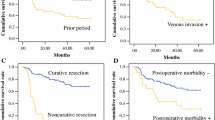Abstract
Background
Remnant gastric cancer (RGC) has a major impact on the long-term survival of postgastrectomy patients. In this study, we established surveillance endoscopy guidelines for postgastrectomy patients based on the risk of RGC.
Patients and Methods
A total of 6365 patients who underwent gastrectomy at Seoul St. Mary’s Hospital from September 2005 to June 2018 were retrospectively reviewed; 85 patients were identified as having RGC. We divided the RGC patients into subgroups according to the interval between primary and secondary gastrectomy.
Results
The curative resection rate was significantly lower in patients with an interval of ≤ 5 years versus > 5 years (p = 0.017). RGC developed more frequently after Billroth II reconstruction, and at the anastomotic site, in patients with a > 10- versus ≤ 10-year interval (p = 0.006 and p = 0.014, respectively). Similar results were observed based on the 15-year interval cutoff (p = 0.001 and 0.018, respectively). The 5-year overall survival rate of patients with a ≤ 5-year interval was significantly lower than that of patients with a > 5-year interval (60.0% versus 85.7%, p = 0.015), while overall survival did not differ between the ≤ 10- and > 10-year, or ≤ 15- and 15-year interval groups. RGC incidence showed a decrease after around 20 years postoperatively.
Conclusions
Thorough endoscopic examination should be conducted for up to 5 years postgastrectomy. Routine annual endoscopic follow-up should be performed for up to 20 years after the primary operation for gastric cancer, to allow for early detection of RGC.



Similar content being viewed by others
References
Jun JK, Choi KS, Lee HY, et al. Effectiveness of the Korean national cancer screening program in reducing gastric cancer mortality. Gastroenterology. 2017;152(6):1319-1328.e1317.
Pasechnikov V, Chukov S, Fedorov E, Kikuste I, Leja M. Gastric cancer: prevention, screening and early diagnosis. World J Gastroenterol. 14 2014;20(38):13842-13862.
Jung KW, Won YJ, Kong HJ, Oh CM, Lee DH, Lee JS. Cancer statistics in Korea: incidence, mortality, survival, and prevalence in 2011. Cancer Res Treat. 2014;46(2):109-123.
Hosokawa O, Kaizaki Y, Watanabe K, et al. Endoscopic surveillance for gastric remnant cancer after early cancer surgery. Endoscopy. 2002;34(6):469-473.
.Mezhir JJ, Gonen M, Ammori JB, Strong VE, Brennan MF, Coit DG. Treatment and outcome of patients with gastric remnant cancer after resection for peptic ulcer disease. Ann Surg Oncol. 2011;18(3):670-676.
Inomata M, Shiraishi N, Adachi Y, Yasuda K, Aramaki M, Kitano S. Gastric remnant cancer compared with primary proximal gastric cancer. Hepato-gastroenterology. 2003;50(50):587-591.
Ohira M, Toyokawa T, Sakurai K, et al. Current status in remnant gastric cancer after distal gastrectomy. World J Gastroenterol. 28 2016;22(8):2424-2433.
Nozaki I, Nasu J, Kubo Y, Tanada M, Nishimura R, Kurita A. Risk factors for metachronous gastric cancer in the remnant stomach after early cancer surgery. World J Surg. 2010;34(7):1548-1554.
Kaminishi M, Shimizu N, Shiomoyama S, et al. Etiology of gastric remnant cancer with special reference to the effects of denervation of the gastric mucosa. Cancer. 1995;75(6 Suppl):1490-1496.
Kondo K. Duodenogastric reflux and gastric stump carcinoma. Gastric Cancer. 2002;5(1):16-22.
Shimada H, Fukagawa T, Haga Y, Oba K. Does remnant gastric cancer really differ from primary gastric cancer? A systematic review of the literature by the Task Force of Japanese Gastric Cancer Association. Gastric Cancer. 2016;19(2):339-349.
Takeno S, Hashimoto T, Maki K, et al. Gastric cancer arising from the remnant stomach after distal gastrectomy: a review. World J Gastroenterol. 2014;20(38):13734-13740.
Lee SB, Kim JH, Kim DH, et al. Clinicopathological characteristics and prognosis of remnant gastric cancer. J Gastric Cancer. 2010;10(4):219-225.
Japanese gastric cancer treatment guidelines 2014 (ver. 4). Gastric Cancer. 2017;20(1):1–19.
Ohashi M, Katai H, Fukagawa T, Gotoda T, Sano T, Sasako M. Cancer of the gastric stump following distal gastrectomy for cancer. Br J Surg. 2007;94(1):92-95.
Ojima T, Iwahashi M, Nakamori M, et al. Clinicopathological characteristics of remnant gastric cancer after a distal gastrectomy. J Gastrointest Surg. 2010;14(2):277-281.
Korean Practice Guideline for Gastric Cancer 2018: an evidence-based, multi-disciplinary approach. J Gastic Cancer. 2019;19(1):1–48.
Kim SB, Lee SH, Bae SI, et al. Association between Helicobacter pylori status and metachronous gastric cancer after endoscopic resection. World J Gastroenterol. 2016;22(44):9794-9802.
Ahn HS, Kim JW, Yoo MW, et al. Clinicopathological features and surgical outcomes of patients with remnant gastric cancer after a distal gastrectomy. Ann Surg Oncol. 2008;15(6):1632-1639.
Komatsu S, Ichikawa D, Okamoto K, et al. Progression of remnant gastric cancer is associated with duration of follow-up following distal gastrectomy. World J Gastroenterol. 2012;18(22):2832-2836.
Takeno S, Noguchi T, Kimura Y, Fujiwara S, Kubo N, Kawahara K. Early and late gastric cancer arising in the remnant stomach after distal gastrectomy. Eur J Surg Oncol. 2006;32(10):1191-1194.
Cho B, Lee CM. Current situation of national health screening systems in Korea. J Korean Med Assoc. 2011;54(7):666–669.
Lee KS, Oh DK, Han MA, et al. Gastric cancer screening in Korea: report on the national cancer screening program in 2008. Cancer Res Treat. 2011;43(2):83-88.
Hong S, Won YJ, Park YR, Jung KW, Kong HJ, Lee ES. Cancer statistics in Korea: incidence, mortality, survival, and prevalence in 2017. Cancer Res Treat 2020.
Acknowledgement
This research was supported by grants from the National Research Foundation of Korea (Grant Nos. 2018R1D1A1B07045486 and 2020R1A2C1012007) and the Korean Gastric Cancer Association. The authors declare no conflicts of interest.
Author information
Authors and Affiliations
Corresponding author
Additional information
Publisher's Note
Springer Nature remains neutral with regard to jurisdictional claims in published maps and institutional affiliations.
Rights and permissions
About this article
Cite this article
Han, E.S., Seo, H.S., Kim, J.H. et al. Surveillance Endoscopy Guidelines for Postgastrectomy Patients Based on Risk of Developing Remnant Gastric Cancer. Ann Surg Oncol 27, 4216–4224 (2020). https://doi.org/10.1245/s10434-020-08517-3
Received:
Published:
Issue Date:
DOI: https://doi.org/10.1245/s10434-020-08517-3




